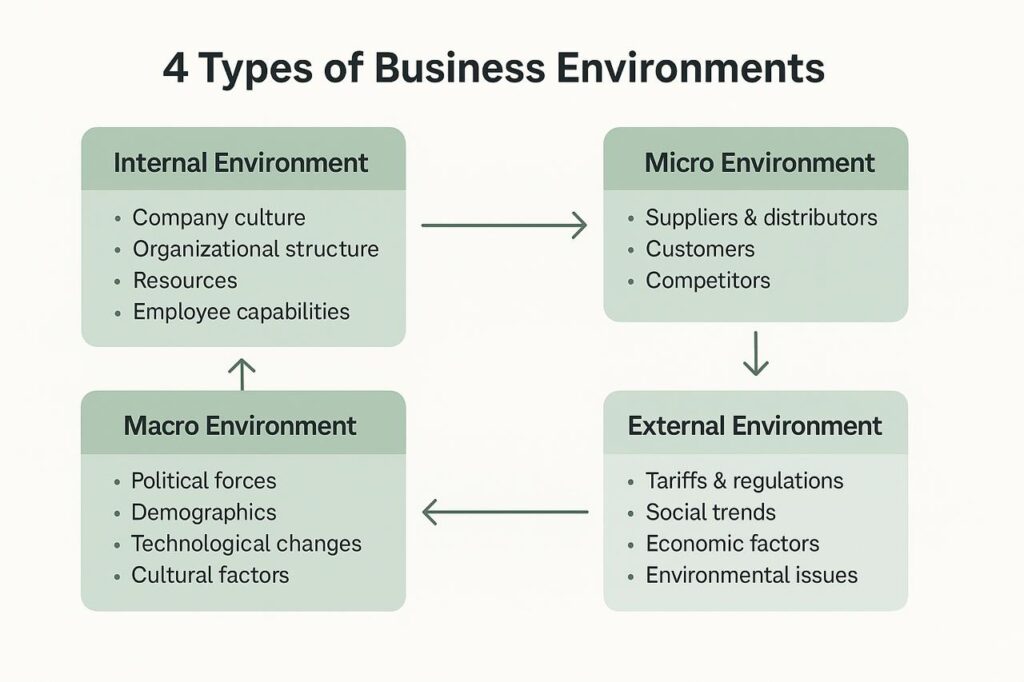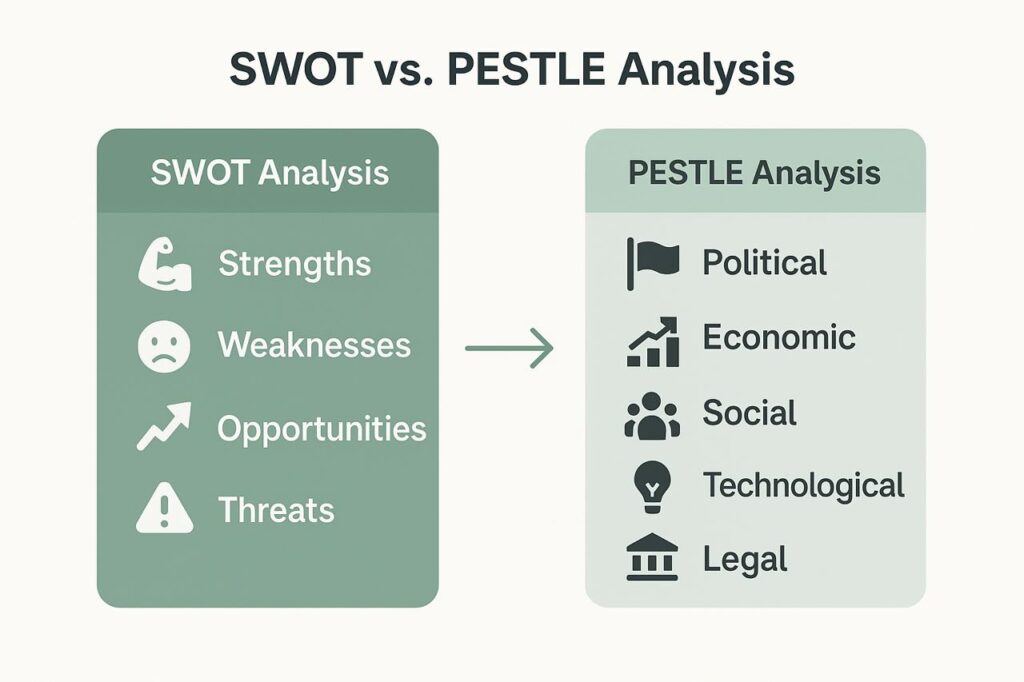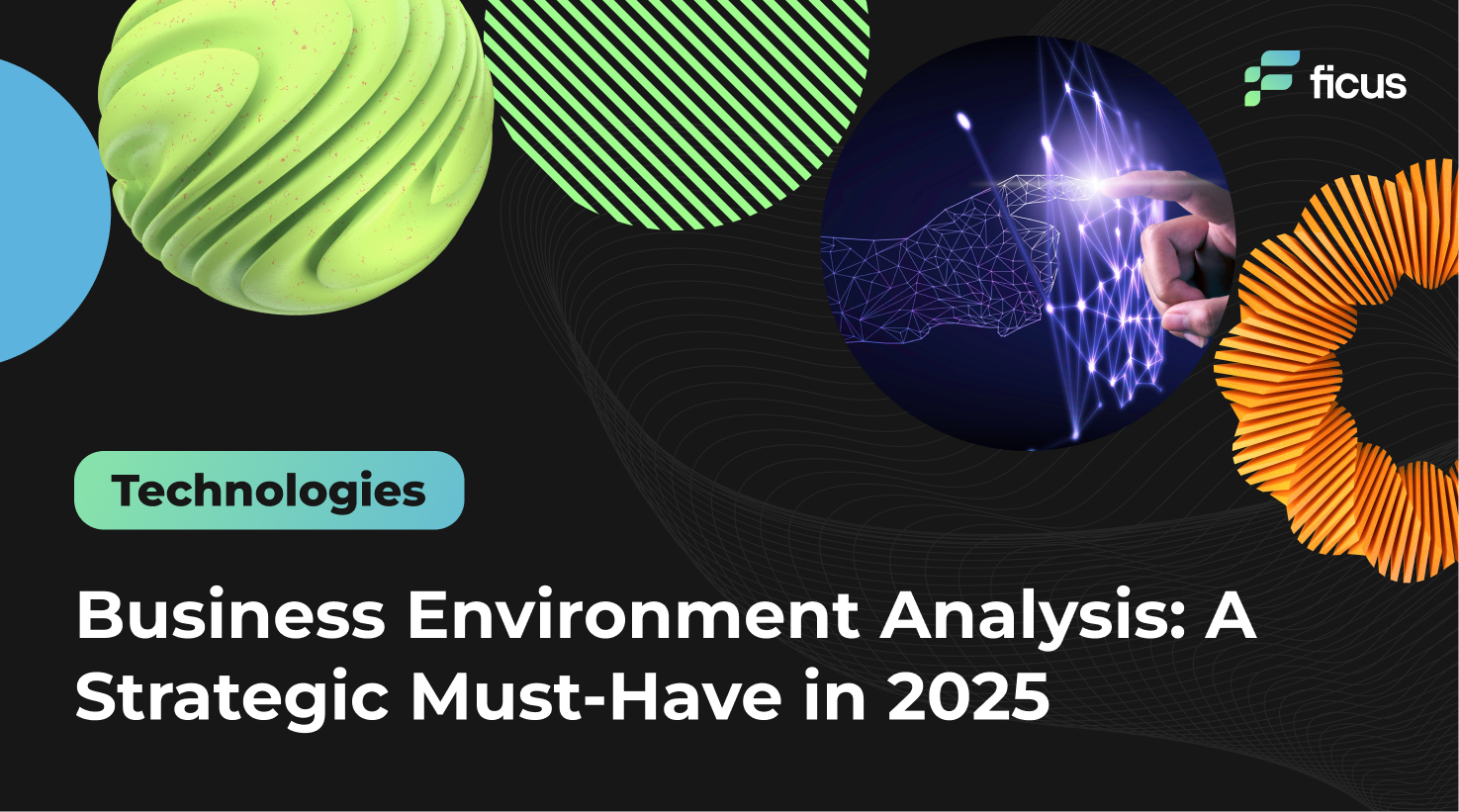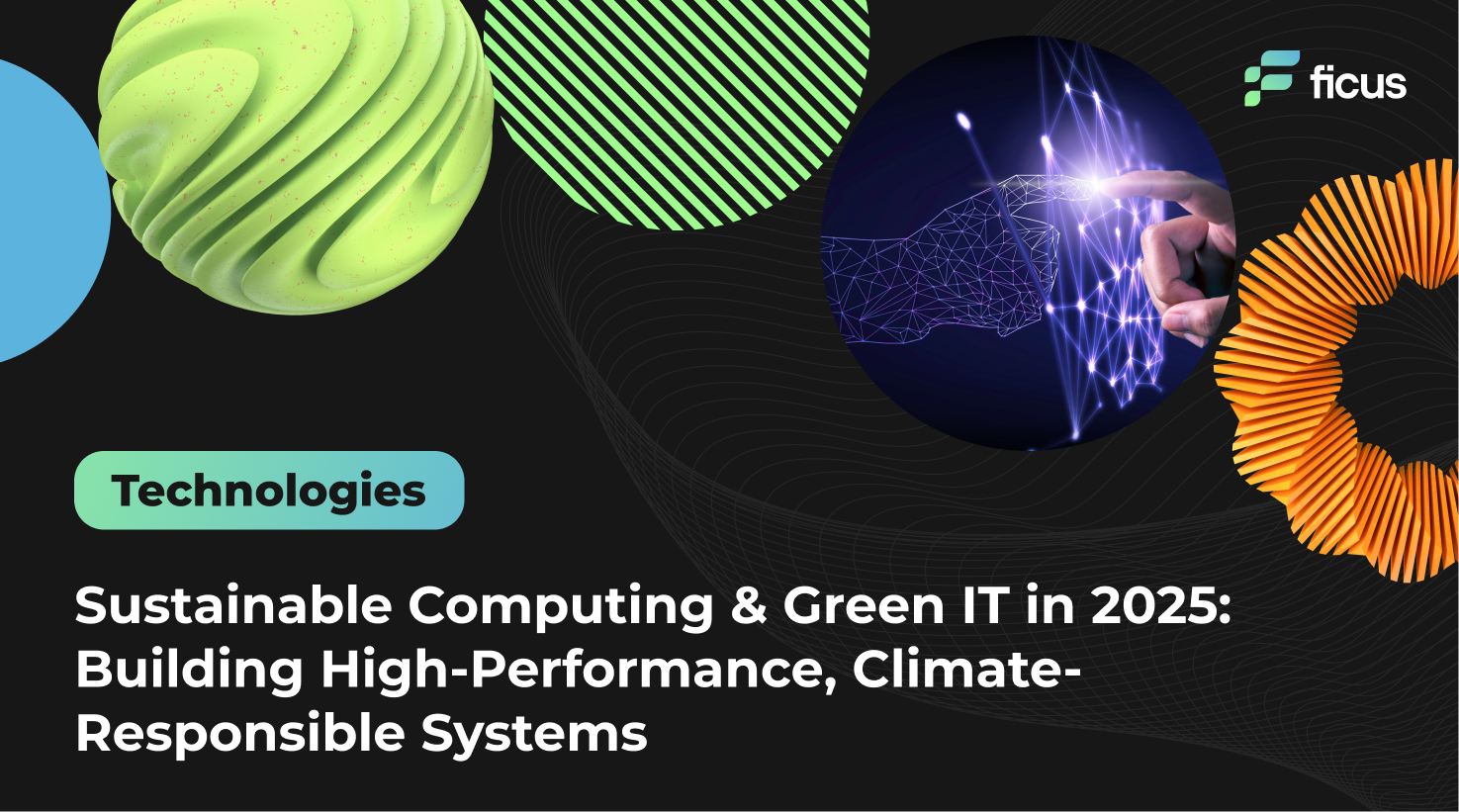In today’s unpredictable global economy, the success of a business depends not only on its products or leadership but also on how well it understands the environment in which it operates. Market shifts, technological disruption, and political or social changes can determine whether a company grows or fails. Business environment analysis allows organizations to systematically evaluate these factors, identify opportunities, and minimize risks.
Founders preparing to enter new markets.
Product and operations managers navigating change.
Analysts and consultants who support executive decision-making.
- Business environment analysis helps detect internal weaknesses and external threats early.
- Frameworks like SWOT and PESTLE enable structured insight and long-term planning.
- Understanding both macro and micro factors improves adaptability and reduces risk.
What Is Business Environment Analysis?
Business environment analysis is a structured process of studying the internal and external elements that affect how a company functions. Internal factors include company culture, resources, and organizational structure. External factors encompass government policy, economic trends, competitors, and technological innovations.
In 2025, this analysis has evolved from static reports into dynamic, data-driven systems. Companies now combine AI-powered forecasting, IoT-enabled logistics tracking, and real-time market intelligence to react to changes as they happen. This integration of traditional frameworks with advanced tools makes analysis not just an optional exercise but a strategic necessity.
Business Environment Analysis: Process & Tools
The process of analyzing the environment requires both structured frameworks and practical execution.
- Identify determinants — Highlight industry-specific drivers such as regulatory compliance in healthcare or cybersecurity rules in fintech.
- Conduct research — Gather insights from official statistics, global reports, and industry-specific analytics.
- Perform competitor analysis — Understand market positioning and track shifts in pricing or innovation.
- Develop scenarios — Build forecasts that show how different external conditions might affect the business.
- Formulate strategy — Translate analysis into concrete actions, such as adapting product offerings or expanding into new markets.
Tools like SWOT and PESTLE remain the foundation, but they are now enhanced with predictive analytics and live dashboards that transform analysis into an ongoing process rather than a one-time task.
4 Types of Business Environments
- Internal Environment
The internal environment covers all factors within the company’s control. Culture, structure, and resources are at the core. A strong culture improves engagement, efficient structures boost agility, and modern resources ensure competitiveness. Human capital is equally vital: data-driven HR practices and talent development align workforce capabilities with long-term goals. - External Environment
The external environment refers to factors beyond the company’s control. These include tariffs, government regulations, trade agreements, and shifting environmental requirements. Businesses cannot alter these forces but must adapt quickly. The resilience of a company often depends on how well it anticipates and prepares for such conditions.

- Micro Environment
The micro environment consists of immediate stakeholders. Suppliers, distributors, customers, competitors, and local communities all influence daily operations. Delays from suppliers, reputational issues in the media, or aggressive competitor strategies can directly affect performance. Building strong relationships and maintaining visibility into this environment are essential for stability. - Macro Environment
The macro environment shapes long-term strategy. Political stability, economic cycles, demographic changes, and technological innovations determine whether industries expand or decline. In 2025, technological disruption and sustainability regulations are among the most influential factors, forcing companies to adopt digital-first strategies and sustainable practices simultaneously.
Internal vs. External: Interconnected Forces
Although often analyzed separately, internal and external environments interact continuously. For example, an organization’s IT infrastructure must adapt to external cybersecurity threats. Employee skill development is influenced by the rise of automation and AI. Strategic leadership decisions are often reactions to regulatory or cultural changes. Businesses that treat these forces as interconnected rather than isolated are more prepared for uncertainty.
Popular Tools for Analysis
- SWOT Analysis
SWOT remains one of the most widely used frameworks because of its simplicity and versatility. In 2025, its value has grown thanks to integration with advanced data analytics and AI-driven forecasting. Rather than just cataloging past strengths, weaknesses, opportunities, and threats, modern SWOT tools allow companies to simulate scenarios in real time.
For example, AI-powered SWOT dashboards can highlight how a new regulation might weaken existing processes, or how a competitor’s product launch creates opportunities in underserved markets. Strengths and weaknesses are no longer static—they evolve as organizations gather data on operations, customer behavior, and competitor positioning. By leveraging predictive analytics, companies can transform SWOT into a forward-looking tool that informs strategy, rather than just describing current conditions.

- PESTLE Analysis
PESTLE takes a broader view, focusing exclusively on the macro-environmental forces that shape industries: political, economic, social, technological, legal, and environmental. In 2025, it is no longer a static checklist but a living, data-driven model. Businesses combine PESTLE with AI-driven analytics, natural language processing, and IoT-based data collection to continuously track shifts in global markets and regulatory frameworks.
For example, PESTLE analysis can reveal the ripple effects of new data privacy laws across entire regions, or anticipate social changes such as sustainability-driven consumer activism. By integrating predictive modeling, companies can not only identify risks but also prepare contingency plans long before disruptions occur. This transforms PESTLE from a periodic strategic exercise into a real-time decision-making asset.
Get a comprehensive business environment analysis tailored to your company’s needs!
Contact UsModern Trends Affecting Business Environment
Several major trends are redefining how organizations approach environmental analysis in 2025:
- AI-Driven Decision Making – Algorithms no longer just summarize data; they provide actionable insights. Businesses use predictive modeling to anticipate customer demand, detect inefficiencies, and optimize resource allocation.
- Remote and Hybrid Work Models – Companies now access global talent pools but face challenges in maintaining collaboration, culture, and productivity across distributed teams.
- Sustainability and ESG Compliance – Environmental and social governance metrics are becoming mandatory, influencing everything from supply chain partnerships to investor decisions. Companies unable to demonstrate ESG alignment risk losing capital and market trust.
- IoT and Connected Ecosystems – With sensors, trackers, and real-time analytics, businesses gain full visibility into their supply chains and operations, enabling faster adjustments to disruptions.
- Global Supply Chain Volatility – Geopolitical tensions, trade wars, and climate events continue to destabilize supply chains. Forward-looking companies mitigate these risks through diversification and digital twins for supply chain simulation.
These trends show that business environments are no longer predictable or linear. Companies that actively integrate these factors into analysis are better positioned to withstand shocks and seize emerging opportunities.
Real-World Application
Consider a SaaS company preparing to expand into a highly regulated international market. Through PESTLE analysis, it identifies strict local data protection laws and economic incentives tied to digital adoption. At the same time, SWOT analysis reveals internal weaknesses in product localization and limited compliance expertise.
Instead of entering the market blindly, the company adjusts its product roadmap: it invests in data encryption, forms local partnerships to address regulatory requirements, and strengthens localization efforts to meet cultural and language expectations. By doing so, the firm not only ensures compliance but also positions itself as a trusted provider in a sensitive market.
This example illustrates how combining both tools creates a multi-dimensional perspective. The external forces reveal what must be adapted, while internal analysis clarifies what can be improved. Together, they enable businesses to launch smarter, reduce risk exposure, and secure long-term success.
Conclusion
Business environment analysis in 2025 is not a theoretical framework but a practical necessity. Companies that integrate continuous analysis into their operations build resilience, anticipate disruptions, and adapt strategies before competitors. By understanding the interplay between internal and external forces, organizations secure a sustainable competitive advantage in volatile markets.
Why Ficus Technologies?
At Ficus Technologies, we empower businesses to transform analysis into actionable strategy. Our approach combines structured frameworks with advanced data tools to ensure decisions are informed, timely, and relevant.
We provide:
- Custom business environment assessments
- AI-enhanced forecasting and predictive modeling
- Industry-specific recommendations tailored to client needs
- Cross-regional expertise for global expansion strategies
With over a decade of experience, a team of senior engineers and analysts, and a focus on measurable outcomes, we help companies turn uncertainty into opportunity.
SWOT focuses on internal strengths/weaknesses and external opportunities/threats. PESTLE is broader, focusing exclusively on external macro-environmental factors.
Ideally, once per year or before major business shifts — such as new product launches, entering a new market, or undergoing structural changes.
Absolutely. Even lean startups gain clarity and avoid risk by understanding their operating environment.
Yes. We provide business environment assessments tailored to your industry, market, and growth stage.








